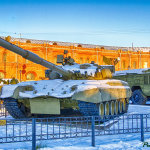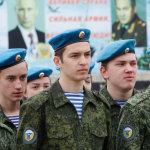When Russia invaded Ukraine on 24 February the T-90M was the best but also rarest tank in the Russian operational fleet. Catastrophic tank losses – over 1,600 of all types – and limited assembly line capacity at Russia’s main tank manufacturer, the Nizhny Tagil-based Uralvagonzavod (UVZ), have forced radical measures. Just two tank types, T-72B3 and T-90M, are now being produced in three daily shifts and with convict labour. The numbers to date remain very small. The former tank is well-known in Western reporting, the newer T-90M less so. This article examines T-90M and the threat it poses.

T-90M Proryv-3 (‘Breakthrough-3’) – pre-war deliveries
The stalled T-14 Armata tank programme aside, T-90M Proryv-3 is the most expensive Russian tank costing 118 million roubles at pre-war exchange rates (approximately $1.6 million). Deliveries only started in 2020, following contract signing in August 2017.1 UVZ Chief Engineer, Pavel Slobodyanik, described this batch as a mix of ‘completely new machines and T-90A, upgraded to the level of T-90M.’ The 2017 contract, in fact, provided for just 30 tanks and only ten were new-builds. The T-90Ms were fitted with ‘thermal imaging sighting systems of domestic production’ (replacing the French Safran Matis STD and Thales Catherine FC thermal cameras with the indigenous Agat-MDT and Irbis-K thermal cameras).2
The pre-war deliveries from the August 2017 and follow-on 2018 contract are summarised below:

The effect of sanctions
UVZ was already an entity in trouble before the invasion of Ukraine. The company’s 2020 financial statement showed the payroll for its 29,748 employees had decreased by 22% with average salaries at 25-30,000 roubles per month ($350-$420). According to news agency TASS, quoting ROSTEC CEO Sergei Chemezov, UVZ’s total debt stood at 87 billion roubles ($1.2 billion). Two months before the war, UVZ Director General Alexander Potapov nevertheless offered an upbeat interview to MOD newspaper Krasnaya Zvezda (he would, of course, have had no knowledge of the impending ‘special military operation’:
‘Today, about 95 percent of our products are Russian-made. The remaining interest falls mainly on the electronic component base. At the same time, we have the opportunity to purchase these components from friendly states and create insurance stocks…I would like to note that the sanctions policy of foreign states, on the contrary, stimulated the work of our designers, technologists, and stimulated our engineering thought. You need to be as independent as possible in terms of technology.’
This confidence was misplaced. In the aftermath of the invasion and with the application of sanctions, almost all work at UVZ ceased. At first, the company refuted reports of closed assembly lines but later conceded some employees had been forced to take leave. Local media reported this was due to the lack of spare parts. Advocate for workers’ rights at UVZ Alexander Ivanov explained:
‘The enterprise is experiencing an economic crisis, the lack of roller bearings for assembling a reinforced rolling stock bogie, the absence of ferroalloys used in metal smelting. It was also announced that UVZ worked at a loss – 7 billion roubles. There is also an order from the management on forced vacations of workers with payment of 2/3 of the salary.’
The potential for a lack of parts in the event of sanctions was previously highlighted in an April 2021 Russian General Prosecutor’s Office audit of import-substitution in Russian defence industry. The report reviewed 117,000 components used in 278 types of military equipment. It found that in 2020 Russian defence firms had hoped to replace more than 18,000 components needed for 43 types of weapons, but substitutes were only found for 3,148 parts for five types of equipment. It also found ‘supplies of critical spare parts for only a third of the planned 7,244 projects’.
UVZ either badly miscalculated, or bluffed over the comprehensiveness of its import-substitution of components and technology.
Post-invasion deliveries
Post the invasion there have been four announcements of T-90M company batch deliveries (10 tanks). The first two were on 16 May and 4 August and announced by ROSTEC (the holding company for UVZ). There is some question over these notices because they were accompanied by obvious public relations images and there was no subsequent reporting of T-90Ms in Ukraine. Nevertheless, they may have occurred and possibly as T-90A upgrades using reserve stocks of components.
More convincingly, on 20th December 2022 UVZ announced the delivery of a company batch of T-90Ms. This was destined for a Central Military District unit presumably subordinate 90th Tank Division. This was followed by a similar announcement on 12 January 2023. The destination of this batch was unclear. In a media claim that seemed to grossly inflate these deliveries Voennoye Obozreniye (‘Military Review’) reported in mid-January: ‘Only in the last months of 2022, the military on the contact line received about 200 new and modernized T-90M Proryv tanks,’ adding these had been deployed to Kherson and Zhaporizhzhia regions as well as the Donbass and ‘a number of ‘nineties’ [had] entered service with PMC ‘Wagner’.’ There is no evidence that 200 T-90Ms suddenly appeared in Ukraine. Voennoye Obozreniye appeared to multiply the December-January deliveries by a factor of ten.

Social media has been helpful in adding evidence to claims of tank deliveries. At the end of December 2022, a Twitter video was uploaded showing as many as 23 T-90M tanks on rail flatcars at Kamenskaya railway station in Rostov-on-Don. T-72B3s and T-62Ms were also observed passing through the station. This was the largest single collection of T-90Ms seen in open source since the start of the war.

Over the same period, six T-90Ms were photographed lined up on a road and, separately, four on heavy-lift transporters. Both groups were reportedly in the Luhansk region.
Impact on the battlefield
T-90M is the most advanced and best protected tank on the battlefield and overmatches all Ukrainian tanks. The main armament is an improved 2A46M-5 gun (also used on the T-72B3s) but with a muzzle reference system (MRS). The latter feature distinguishes the model from all other Russian tanks. However, guns are only as good as the rounds they fire and the advanced rounds (Svinets series) are in short supply. The Kalina digital fire-control system (FCS) is integrated with advanced commander and gunner sights with day and TI channels. The Relikt ERA is an improvement on Kontakt and the 3VD35 aerosol grenades are impressive (see image below).

The number of lost T-90Ms is statistically too small to draw conclusions. Just ten are recorded as lost by the Oryx database, of which four were destroyed and the remainder damaged, abandoned or captured. Ukraine claims it has captured 14 T-90 series tanks of which two are T-90Ms and the remainder T-90As or the export T-90S variant.3 The example of the T-90M belonging to 4th Guards Kantemirovskaya Tank Division captured in perfect condition near Izyum was widely reported.

Of the four destroyed tanks, two were ‘pop-tops’ (turret removed by catastrophic detonation of the ammunition). The three damaged tanks were struck by an AT-4 rocket, shell splinters from an M982 Excalibur; and by a Ukrainian Skif ATGM. In all cases, exterior fires were started after the covers appeared to catch light. The most notable incident was the catastrophic detonation of a T-90M caused by dropping an RKG-3 HEAT grenade on the turret top from a quadcopter – or $1.6 million’s worth of tank destroyed by a grenade costing a few hundred dollars.

Technical detail matters but how tanks are used is equally important. One of the great surprises of the war has been woeful use of a machine venerated in Russian military culture. There is not a city in Russia that does not have a tank memorial, yet tanks have been used poorly in this war. Combined arms tactics have been a significant weakness. Today, abundant social media clips and shorts on TV Zvezda show Russian tanks being employed singly or in pairs as roving howitzers. This was not the reason why the tank was invented. Unless Russian tank employment radically changes it appears unlikely T-90M will live up to its name and ‘breakthrough’.

Conclusion
The war came as a total surprise to Uralvagonzavod. Claims for the success of import-substitution proved unfounded; tank production stopped. Almost ten months later production has resumed but in very limited quantities. Open source suggests 2-4 company batches of T-90Ms depending on whether the May and August delivery announcements are believed. This is wholly inadequate to compensate for weekly battlefield losses and, obviously, overall losses. At this rate of production and including T-72B3s it would take UVZ roughly 30 years to build-up the Russian Army’s tank fleet to its pre-war strength.
2023 will be crucial. Over the course of the year it should become clearer whether UVZ has overcome its problems and can ramp up serial production. It should also become evident whether the Russian Army has learnt anything. T-90M Proryv-3 is a fine tank. Rumours are swirling of a Russian offensive in February-March. In the hands of inept Russian command it may be more metal waiting to become junk.
Cover photo is a Russian T90M in April 2020.. By Mil.ru, CC BY 4.0, https://commons.wikimedia.org/w/index.php?curid=89108860
Sergio Miller
Sergio Miller is a retired British Army Intelligence Corps officer. He was a regular contributor and book reviewer forBritish Army Review. He is the author of a two-part history of the Vietnam War (Osprey/Bloomsbury) and is currently drafting a history of the Russian invasion of Ukraine.
Footnotes
- Russian defence contract signings, commonly coinciding with the annual ARMY expos can be opaque and confusing. There is suspicion of repeat announcements or statements of intent for public relations purposes, but not commitment. At ARMY-2018 another contract for 30 T-90Ms was announced. At ARMY-2019 it was announced the MOD had signed a contract to upgrade 100 T-90A tanks to T-90M standard. At ARMY-2020 it was reported ‘about 100 more T-90 tanks would be upgraded to the level of T-90M.’ At ARMY-2021 Deputy Minister of Defence Alexei Krivoruchko announced ‘the army will receive 65 serial T-90M Proryv tanks.’ This latter number is closest to reality.
- One example of a captured T-90 was found to be fitted with the French optronics.
- Oryx also records 31 T-90As and 3 export T-90Ss destroyed, damaged, abandoned or captured.





